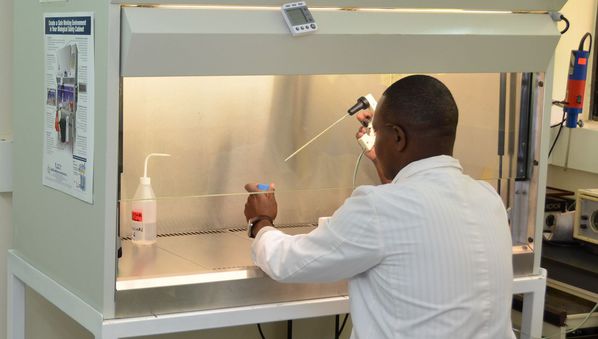R&D spending is irrelevant without links to SDGs

African nations need to introduce a measure of how spending aligns with development targets, says John Ouma-Mugabe.
The past decade has witnessed a surge of interest in science and technology in Africa. At the January 2007 African Union (AU) summit, leaders agreed a target to increase gross national spending on research and development (R&D) to at least one per cent of GDP (gross domestic product). [1]
This may reflect the leaders’ recognition of the economic role of science and technology in general and R&D in particular. However, many African countries mistakenly equate high levels of R&D spending with investment in technological change.
In some instances, R&D expenditure is considered a prerequisite to economic growth — but this is also misguided. Economies can grow without high R&D spending. Some of Africa’s largest and fastest growing economies — such as Angola, the Democratic Republic of Congo and Mozambique — spend less than 0.5 per cent of GDP on R&D, while South Africa spends around 0.8 per cent but has relatively low growth.
“One should not underestimate the potential benefits of R&D, which are not just economic: they also include scientific advancement and contributing to the shared knowledge pool.” John Ouma-Mugabe, GSTM, University of Pretoria
One should not underestimate the potential benefits of R&D, which are not just economic: they also include scientific advancement and contributing to the shared knowledge pool, so countries can assert themselves better globally. However, a misleading view that R&D automatically leads to economic growth pervades many policies of African countries. And it comes with a misplaced emphasis on quantity rather than quality.
No economic basis
To begin with, the one per cent target is not based on any economic rationale. Relatively developed as well as poor African countries have adopted the same target, and have done so without really considering their R&D needs and technological readiness.
In Burundi, for example, one of the world’s poorest countries, not much has changed since it developed a policy framework that is based on the one per cent target in 2012: its R&D spending is about 0.1 per cent of GDP and likely to decline because of political instability. Yet Burundi needs investments of more than one per cent to build a productive infrastructure in R&D, and educational and private sector institutions.
Adopting the R&D spending target means nothing unless governments do something about it. And each country needs to set its own priorities and establish feasible financing mechanisms. Some, for example, may have small initial targets and increase them as their R&D and innovation systems expand.
So why did African countries adopt the target?
- Peer pressure
- Expectation of rapid economic benefits
- Prestige and a desire for scientific hegemony
- Because they are members of the AU or a regional bloc such as the East African Community or the Southern African Development Community that backed the idea
Policy disconnect
In reality, the one per cent target obscures the fact that most African countries have not adequately incorporated science, technology and innovation (ST&I) into their mainstream policies. This is true even in more industrially advanced nations: South Africa’s and Kenya’s development plans say little about R&D and ST&I. [2,3] The spending target is not explicitly focused on development and can be met without necessarily achieving development or economic growth goals.
Furthermore, choices around R&D and technology are generally discussed at the periphery of development policy and planning. It is science and technology departments and science councils that get preoccupied with them, while national treasuries and economic planning offices generally seem disinterested, and are rarely seen in national and AU forums on ST&I even if they stimulate political attention.
And there are instances of African leaders declaring that their countries have attained the one per cent target without having the evidence needed to monitor national R&D spending.
‘Intensity’ of spending
Where the spending target has focused political attention on ST&I, this has opened up space for designing wider policy frameworks in this area. The challenge, then, becomes more about the relevance, quality and ‘intensity’ of national R&D spending.
This is important particularly as the world moves towards the post-2015 development agenda. Development-based R&D targets go beyond financial spending: they are about expanding societal capabilities to fight poverty, reducing the burden of disease and engaging in ecological stewardship and democratic governance.
“It is time for each nation to critically examine its needs and set R&D spending targets that are achievable and drive their development.” John Ouma-Mugabe
R&D spending and related indicators should be linked to the post-2015 agenda through a measure such as development-based R&D intensity: the amount of knowledge production activities explicitly linked to generating a solution to a specific human development challenge.
A country’s health R&D intensity, for example, would comprise the total funding, number of researchers and technicians, value of infrastructure and months directly invested in searching for a solution to a particular disease or health challenge.
As African countries and their partners start designing post-2015 programmes, they need to focus on linking them to R&D spending by identifying specific ways in which ST&I can contribute to attaining the Sustainable Development Goals. Some African countries are starting to design development-based ST&I policies. The Seychelles government is already formulating such a policy and strategy, and Namibia may be embarking on a similar process soon.
Uniform targets conceal the scientific and economic diversity of African countries. It is time for each nation to critically examine its needs and set R&D spending targets that are achievable and drive their development.
SciDev